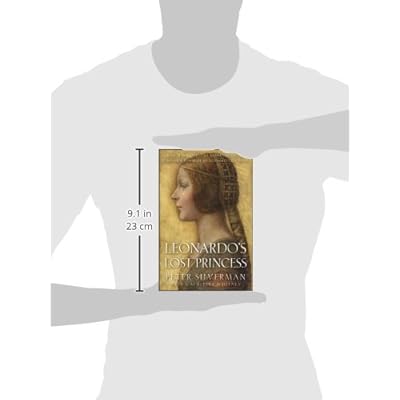Leonardo's Lost Princess: One Man's Quest to Authenticate an Unknown Portrait by Leonardo Da Vinci
Category: Books,Arts & Photography,Drawing
Leonardo's Lost Princess: One Man's Quest to Authenticate an Unknown Portrait by Leonardo Da Vinci Details
From the Inside Flap The memory had haunted Peter Silverman for nine years. In 1998, he had seen an exquisite nine-by-thirteen-inch portrait of a lovely young woman in a richly detailed costume. As much as he was captivated by its beauty, he was intrigued by the catalog annotation, which said it was "German, early 19th century." He was certain that the piece was either a genuine Renaissance work or a brilliant forgery. He resolved to pay up to twice the minimum estimate for this extraordinary jewel at auction, but when the time came, he lost his nerve at $17,000. Now, nine years later, here it was again, for sale in a Manhattan gallery. It would not escape his grasp this time. Still, he had no inkling of the momentous discovery he was about to make or the great controversy that would follow.In Leonardo's Lost Princess, Silverman tells the riveting story of how his initial suspicions of the portrait's provenance grew as one art expert after another confirmed his view that this haunting image was, indeed, created in the fifteenth century, that the artist was certainly left-handed, and that the quality of the work was extraordinarily fine. Few, least of all Silverman himself, were willing to even hint that it was the rarest of all finds, an original masterpiece by the greatest painter in history. More proof was needed, but where could it be found?Silverman's account of the cutting-edge science used to authenticate the portrait—from radiocarbon dating to multispectral photography—is as fascinating as it is convincing. Not only were scientists able to prove that the materials dated from Leonardo da Vinci's lifetime, an analysis of photos taken of the portrait using thirteen different light spectra revealed beyond doubt that the work was made by the master himself. They also provided hints to the drawing's history over the intervening centuries.Still, many questions remained unanswered. Who was this poised and beautiful young woman? Why had Leonardo, who was very busy at the time with multiple projects for his patron, the Duke of Milan, and others, spent valuable time making this small and modest portrait in chalk and ink? Where had it been hiding for five centuries? The answers to these questions could only be found through good, old-fashioned research and legwork, which would take investigators from Paris to Milan to, improbably, Warsaw. The answers they found are surprising, revealing, and often moving.Complete with vivid accounts of the art-world controversy sparked by Silverman's claim, similar controversies over the authenticity of works supposedly by Leonardo, and the very different lives of Leonardo and the lovely young woman who was his subject, Leonardo's Lost Princess is part whodunit, part revealing exposé, and all-enthralling tale of an impossible dream come true. Read more From the Back Cover A Princess FoundIn 1496, a beautiful princess was preparing to marry in Milan. Bianca was the daughter of Duke Ludovico Sforza and betrothed to Galeazzo Sanseverino, commander of the duke's armies. Portraits were often commissioned during the Renaissance to mark major events in a subject's life, and a court artist named Leonardo da Vinci was given the task of memorializing Bianca.Tragically, the princess died soon after her wedding. Then her portrait, the last evidence of her existence, was also lost.At a New York City gallery in 2007, Peter Silverman saw a portrait catalogued as "German, early 19th century." Thinking it misattributed and regretting not buying it once before, he scooped it up for a mere $19,000 and began a long quest to discover its origins. He hardly dared utter the "L" word: Leonardo.Giants in the field of art history and scholarship soon would, though, as the best of connoisseurship was used to authenticate La Bella Principessa. Science would then confirm their judgments. The picture was carbon-dated, digitally examined with multispectral imaging, even scrutinized for fingerprints—and one of Leonardo's was found along with a palm print. Bianca was identified as the subject, and her clothes and hair were matched to those of her period.Many in the art community still would not believe, but Silverman persisted and, with the help of Leonardo scholar Martin Kemp, discovered its provenance: the tribute book from which the picture had been removed. After more than 500 years the beautiful princess was home again.The picture is valued at $150 million, but its value to the art world is incalculable—and its story is unforgettable. Read more About the Author PETER SILVERMAN is a noted art collector. Among his significant discoveries are three miscatalogued works by Van Dyck and a wooden cross attributed to Michelangelo.CATHERINE WHITNEY has written or cowritten more than fifty books in a variety of fields. Read more

Reviews
I loved this book so much, I read it twice! After the first reading, I was so excited, I selected it as the subject for our woman’s study club, purchasing the book for 12 other members. Every single lady raved about the book – not only because of the interesting subject matter, but also because the book reads like a mystery novel! Comments such as “I probably would have never chosen this book, but I couldn’t put it down!” and “I’m so glad that I read this book, it was incredibly interesting!” I couldn’t agree more. It is a fascinating and moving story - a real page turner.Peter Silverman is a noted art collector and connoisseur who purchased a chalk, pen and ink portrait of a young girl from a New York gallery, described to be a German, early 19th century work. Because of its quality, Silverman was certain that the piece was either a Renaissance work by a great master or by that of a brilliant forger. With remarkable resolve, Mr. Silverman engaged not only art experts to examine the work, but scientific dating experts to prove that the work is indeed of the Renaissance. Their research takes them through many twists and turns to Paris, Milan, London, and Warsaw, in the end proving, beyond a doubt, the portrait is by the great master, Leonardo da Vinci.



